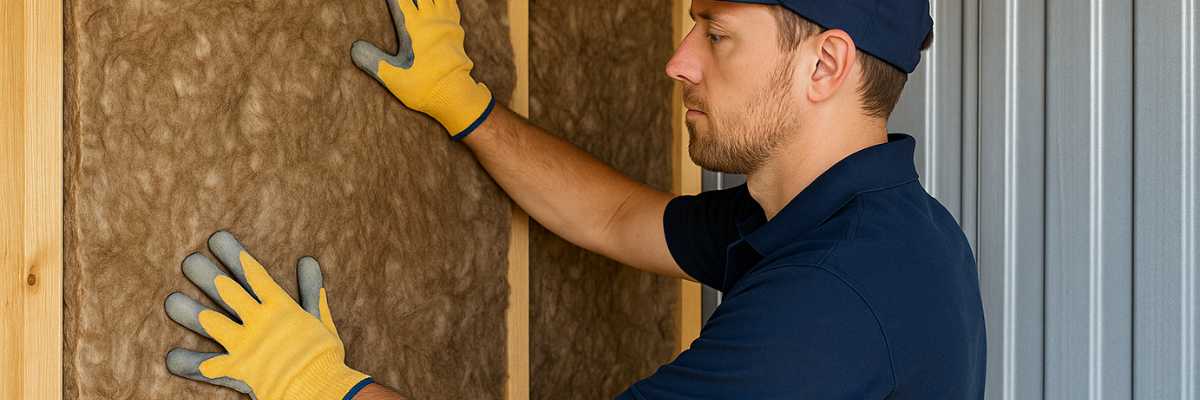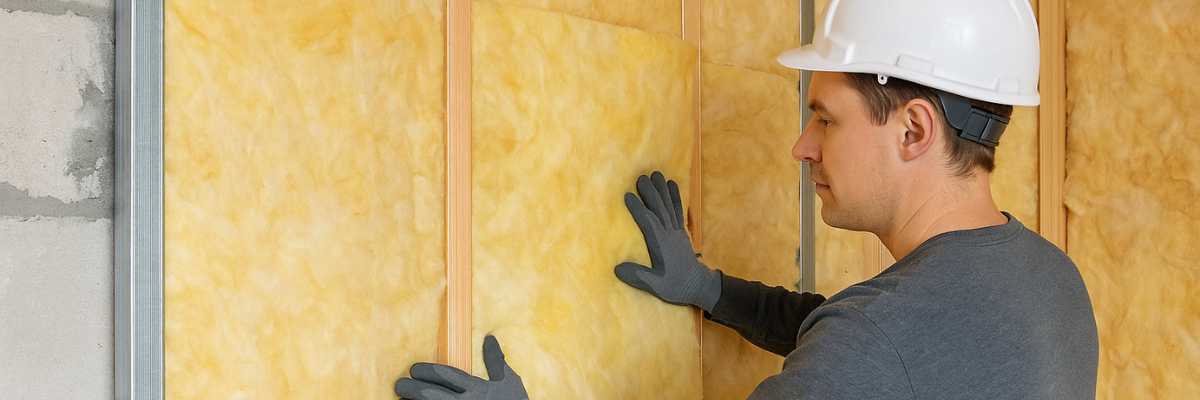If a shed is utilized as a living space or workspace, insulation is essential. You can use this for controlling temperature, shielding stored goods from inclement weather, and creating a comfortable atmosphere. Certain kinds of sheds, such as workshops, living areas, and storage sheds, require different kinds of insulation. This blog seeks to investigate the best shed insulation alternatives, considering installation simplicity, cost, and climate. You may improve the longevity and usability of your shed by choosing the right type of shed insulation.
What Factors You Should Consider When Choosing Shed Insulation
Climate
The type of insulation that will work best for your shed depends largely on the local environment or climate. High R-value materials or reflective insulation assist in reflecting heat, keeping the shed cool in warmer climates. Thick insulation, such as fibreglass or foam, is necessary to keep warmth in colder climates. Moisture-resistant insulation is essential in humid environments to avoid mildew and mould growth.
The Shed's Purpose
How the shed is used determines how much insulation it needs. A workshop needs more extensive insulation for year-round comfort; whereas a storage shed might simply need minimal insulation to shield goods from temperature fluctuations. Like guest houses or workplaces, livable sheds require superior insulation to regulate temperature and block out noise.
Budget
The kind of insulation you select will depend on your financial situation. Although rigid foam and spray foam panels function exceptionally well, their costs are higher. Although they are less expensive, fibreglass batts and reflective foil could not offer as much insulation. Efficient insulation must be balanced with cost.
Ease of Installation
Another crucial factor to consider is installation ease. Installing materials like fibreglass batts or reflective foil is not too difficult for DIY enthusiasts. To ensure efficacy and safety, more sophisticated solutions, such as spray foam, might need to be installed by a professional. Depending on your abilities, available tools, and the type of insulation, you can choose between DIY and professional installation.
Major Types of Insulation for Sheds, Available in Australia
Depending on the particular requirements of your shed, several materials offer differing benefits when it comes to insulation. It is critical to select the insulation type that best suits your requirements. Because each type has pros and cons of its own.
Batts Made Of Fibreglass
One of the most popular and reasonably priced insulation choices is fibreglass batts. They are supplied in pre-cut panels that slide neatly in between the shed ceiling and wall studs. Fiberglass batts are a great DIY alternative because of their good thermal performance, cost, & ease of installation.
They are less suited for humid areas. However, they are less successful at sealing air leaks and may lose their efficiency if they get wet. Fibreglass batts work well in sheds where there is a reasonable demand for moisture management & a fast, affordable fix.
Insulation Using Foam Boards
Rigid panels composed of polystyrene, polyisocyanurate, or polyurethane make up foam board insulation. These boards are perfect for sheds in humid locations since they have good moisture and heat resistance. In addition to being simple to cut and assemble, foam boards give the shed walls some structural support. The drawbacks of foam boards include their potential higher cost in comparison to other forms of insulation. You can also avoid this because of the possibility of extra edge sealing to stop air leakage. They work great on ceilings as well as walls, especially in sheds where moisture is an issue.
Insulation Using Spray Foam
Spray foam insulation is a flexible choice that works well in sheds with uneven shapes and in difficult-to-reach places. When foam is used, it expands to close up holes & crevices, producing an airtight seal that significantly improves energy efficiency. With its high R-values, spray foam offers excellent thermal insulation. The primary disadvantages are the increased expense and the requirement for expert installation to guarantee efficacy and safety. For sheds that need a lot of insulation, spray foam is perfect. You can use this, especially in hard-to-reach places like corners, joints, & the spaces surrounding windows and doors.
Insulation Made Using Reflective Foil
Reflective foil insulation is very useful in hot regions because it works by reflecting radiant heat away from the shed. This kind of insulation is made up of a layer of reflective aluminium foil. And it is frequently topped with foam or bubble wrap for further insulation. It can be applied to floors, walls, and ceilings and is lightweight and simple to install. Reflective foil works wonders to reduce heat absorption. But in colder areas, where heat retention is more crucial, it is less effective. It works best for sheds in warm, sunny climates where maintaining a cool interior is the main objective.
Insulation Using Natural Fibers
An environmentally friendly alternative to shed insulation is natural fibre insulation. This is manufactured from materials like wool, cotton, or recycled denim.
In addition to having favourable thermal properties, these materials are biodegradable and renewable. And frequently, they have less of an environmental impact than synthetic alternatives. Wool, for example, is a useful material for sheds in a variety of climates because it naturally controls moisture. However, insulation made of natural fibres is more expensive & can need to be treated to keep mould and pests out. The greatest candidates for this kind of insulation are those who value sustainability above all else; and are prepared to spend a premium on an eco-friendly solution.
Installation Tips for Shed Insulation
The best possible performance from your shed insulation depends on proper installation. You can make sure that your shed stays cozy, energy-efficient, and weatherproof by following these guidelines.
Getting the Shed Ready
It is crucial to properly prep the shed before adding insulation. First, give the interior a thorough cleaning to get rid of any old insulation, dust, and dirt. This ensures that the new insulation fits correctly and performs as intended. Next, you can use caulk or expanding foam to close up any holes, cracks, or gaps in the shed's framework. To avoid drafts and moisture intrusion, which could reduce the insulation's effectiveness, this step is essential. Before adding insulation, evaluate the shed's structural virtue to find any locations that might require strengthening or repair.
Methods of Installation
Depending on the kind of insulation you select, there are different installation techniques:
Fibreglass Batts: To ensure a snug fit, install batts between the shed studs. If required, secure the batts with staples to the studs & cover them with a vapour barrier to keep moisture out.
Foam Board Insulation: You can use screws or adhesive to fasten the stiff foam panels in place between the studs. To stop air leaks, tape or foam sealant can be used to seal the edges.
Spray Foam Insulation: Hiring an insulation professional is advised for spray foam. The foam is sprayed directly onto the ceiling and walls of the shed; expanding to seal crevices and form an airtight enclosure.
Insulation Using Reflective Foil: Attach the foil directly to the shed's walls and ceiling using staples or tape. The reflective foil should be directly stapled or taped to the shed's walls and ceiling. To enhance the reflecting side's capacity to reflect radiant heat, make sure it faces outward.
Insulation Made of Natural Fibers: Installing natural fibre insulation is comparable to installing fibreglass batts. If needed, you may secure the material with a vapour barrier after sandwiching it between the studs.
Control of Moisture
Controlling moisture is essential to avoiding problems like rot, mould, and mildew. It is imperative to install a vapour barrier, particularly in humid regions or areas where condensation is a possibility. You can install a vapour barrier on the hot side of the insulation. This will prevent moisture from soaking into the material. Furthermore, make sure your shed has enough ventilation to let moisture out. It will support keeping the shed's interior dry and hygienic.
Sealing Air
To maximize the efficacy of your insulation, air sealing is essential. The efficacy of the insulation to control temperature can be diminished by even tiny cracks that let air in or out. Once the insulation is in place, make sure to properly caulk all edges, joints, & gaps around windows, doors, and corners. To establish an airtight seal, use weatherstripping, expanding foam, or caulk. This technique helps keep moisture and pests out while also increasing energy efficiency.
Insulation Material Comparison: Cost vs. Performance
It is critical to weigh upfront expenditures and long-term performance when selecting insulation for your shed.
The initial costs: Spray foam insulation is more expensive; often costing between $ 25 and $ 50 per square meter. Fiberglass batts are the least expensive, costing between $ 5 and $ 10 per square meter. Natural fibre insulation and foam board are in the middle.
Long-term savings: Depending on whether your shed is heated or cooled, long-term savings may apply. By preserving constant temperatures, good insulation can drastically cut energy expenses for heating and cooling. Even though it costs more upfront, spray foam has great energy efficiency and can eventually pay for itself.
Lifeline: In terms of longevity & maintenance, foam boards and spray foam have a lifespan of more than thirty years. And they require very little care. Fibreglass batts may require replacement after 15 to 20 years due to deterioration over time; especially if they are exposed to dampness. Although natural fibre insulation is environmentally benign, it could need more regular upkeep to keep pests & moisture out.
Special Considerations for Different Shed Uses
The main goal of storage shed insulation is to shield contents from extremes in temperature and moisture. To avoid damaging stored items, you should use insulation that offers superior moisture control and temperature resistance. You can go for fibreglass batts or foam boards.
Insulation is essential to preserving comfort in workshops throughout the year. The room may be used in both hot and cold weather thanks to adequate insulation, which helps to manage temperature. If loud tools are also used, soundproofing is essential. Therefore, consider insulating options like stronger fibreglass batts or spray foam, which have both thermal and acoustic benefits.
Higher insulation requirements apply to livable sheds, which include guest homes, studios, and offices. Choose high-performance insulation, such as spray foam or foam board, which gives superior heat resistance and airtightness. This will ensure that these areas are as pleasant as any other room in the house. In these situations, maintaining energy efficiency, soundproofing, and moisture management are also essential for a year-round habitable space.
Conclusion
Your shed's intended function, environment, and financial constraints all play a role in the insulation you choose. Foam boards resist moisture, fibreglass batts are reasonably priced, and spray foam has exceptional energy efficiency. Maintaining proper temperature and moisture control is important for storage sheds; high-performance insulation is necessary for habitable sheds to ensure year-round comfort; workshops benefit from insulation that improves comfort and soundproofing. Appropriate insulation ensures long-term comfort and energy savings in addition to protecting your shed and its contents.







